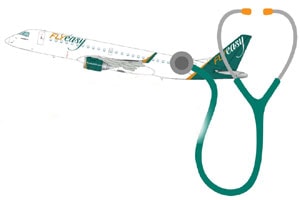Fly Easy, the subsidiary of Bangalore-based ABC Aviation and Training Services, has applied for air operating permit (AOP) with the Directorate General of Civil Aviation (DGCA). Officials at the aviation regulator said the document verification of Fly Easy is in progress and is likely to get the permit in the next four to five months.
Since 2011, Fly Easy is one of the 16 airlines to have taken no-objection certificate from the ministry of civil aviation to start commercial operations. Of the 16, only four got AOPs — Air Asia, Vistara, Air Costa, and Air Megha. Premier Airlines, which has taken a pan-India NOC, held informal discussions to apply for AOP with the DGCA. “Premier has not approached us formally,” said officials. Air Costa and Air Megha are regional airlines in South India. Once Fly Easy, owned by businessman Rajesh Ibrahim, gets the AOP, it will be the third south-based regional carrier.
DGCA officials said document verification is the first step after an airline is given NOC, followed by demonstration phase and certification phase. Fly Easy is known to have started hiring pilots for the demonstration phase, which takes into account the flight safety parameters that carriers have to follow. The last stage — the certification stage is after which airlines can start opertions.
Less than a month ago, aviation secretary RN Choubey said at a conference his biggest concern is to increase regional connectivity. With the growth of regional carriers, he expects this problem to be solved.
However, experts said the biggest challenge is lack of airports in smaller towns and cities. India has a total of 140 airports, but to get regional connectivity going, it will require around 200-300 airports.
The government is also looking at making aircraft acquisition cheaper. Regional carriers need smaller aircraft, and the government is mulling over giving subsidies to smaller plane operators. Fly Easy has inducted an Embraer 190-LR, which is a small aircraft with 70 seats. “They have one plane and according to the current rules, they will require five aircraft in five years,” said officials.
However, the application for AOPs for airline companies have been slow, said officials. For example, Premier Airlines, which applied for NOC in 2011, is yet to apply for a formal AOP. It has already got five extensions to apply for the permit, and is yet to make one.
According to aviation experts the last few years have been bad for the aviation industry because of financial strain and regulatory uncertainties. However, with the new aviation policy right round the corner, and at least one airlines coming out of loses — SpiceJet, the DGCA expects the situation to improve. Global consultancy firm KPMG also came out with a report earlier this year stating that 2020, India will be the world’s third largest aviation industry.

